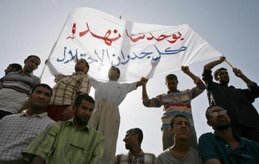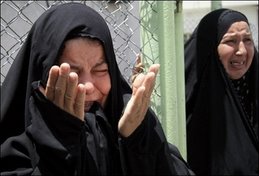Bucca: U.S. brings Iraq prison camp out of black hole
Reuters
By Peter Graff
In the visiting hall of the U.S. prison camp, Delal Hashem, 25, sat opposite her husband Abbas Daoud Salman with the children she had brought to see him for the first time since he was captured 14 months ago.
Amna, the infant daughter who had never seen her father, clung to her mother's neck. Four-year-old Abdullah put his arms around his father, who smiled silently.
"They miss him. It hurts," their mother said.
Approached from the air, the U.S. military's Camp Bucca detention centre emerges from desert heat haze like a cross between a mediaeval fortress and a run-down suburban trailer park. The first thing you notice is its staggering size.
Home to 8,000 jailers and more than 15,000 prisoners from all over Iraq, it lies in a remote brown wasteland along the Iraqi-Kuwaiti border surrounded by razor wire, guard towers and scrap metal junkyards.
Its bakery produces 150,000 pitas a day. Its purification system churns out 700,000 gallons of drinking water. Guards on 40 towers peer out and in, round the clock, rifles ready.
"Bucca," says Brigadier General David Quantock, in charge of U.S. detentions in Iraq, "is the seventh wonder of the world."
The camp is the main centre of a vast archipelago of U.S. military detentions that has ensnared tens of thousands of Iraqis over 5 1/2 years of war, the vast majority held for months or even years without any charge or legal representation.
The U.S. military says the system has been completely overhauled since the Abu Ghraib debacle in 2004, when photographs of soldiers sexually humiliating detainees brought the military into global disgrace.
With violence across the country at four-year lows, detainees are now being freed faster than they are captured. Bucca is slated to be emptied by the middle of 2009.
But for many Iraqis, especially Sunni Arabs who make up 80 percent of detainees, that is not soon enough.
"We demand the closure of the American prisons and the release of the detainees in the framework of a suitable agreement," Iraq's Vice President Tareq al-Hashemi, a Sunni Arab, told Reuters.
"Definitely it is not enough. The daily releases are not noticeably decreasing the total number of detainees. The (prisons) are still crowded."
FUNDAMENTAL CHANGE
A fundamental change in U.S. detentions is coming soon.
Their legal basis -- a U.N. Security Council resolution authorising troops to hold anyone they consider a threat indefinitely and outside the reach of Iraqi courts -- expires at the end of this year.
U.S. officials say they are scrambling to meet that deadline to bring their detention system in line with Iraqi law.
In the past, only about a quarter of incoming detainees were charged in Iraqi court. Over the past month, U.S. troops have raised that rate to nearly half, and they will ensure all future prisoners are charged after January 1, Quantock said.
Asked about the status of prisoners already held without charge who are still in detention centres after the new year, he said: "Good question."
In the meantime, the military says it is setting detainees free as fast as it thinks it safely can, a rate of about 50 a day, or about twice as fast as it brings new ones in.
The plan is to reduce the number to around 7,000 and shut Bucca down by mid-2009, transferring the remaining detainees to another camp at an air base near Baghdad.
"We can't just open the gates," said Quantock. "Most of our detainees are between 18 and 26. You don't want to take 15,000 detainees and throw them into the battle space."
"HAPPY BUS"
Bucca may be a huge improvement over Abu Ghraib, but it has seen its share of problems. In the middle of last year the camp saw "tremendous riots," Quantock said, with hundreds of inmates "throwing rocks and burning tents."
On May 14 this year, guards locked eight detainees in a steel cell that had been sprayed with pepper spray, and switched off its ventilation. The Navy has charged six sailors with abuse over the incident and administratively punished seven others.
"There had been some detainee-on-guard issues (that day) which ranged from spitting to throwing bodily functions at some guards," Navy spokeswoman Commander Jane Campbell told Reuters in August when the charges were announced.
Quantock, first sent to Iraq in 2004 in the wake of the Abu Ghraib scandal, has returned to run the detention system after writing a new detentions manual that stresses rehabilitation.
Commanders now describe detention as part of a wider counter-insurgency strategy aimed at winning hearts and minds.
"Back in the day, we'd just hold 'em," said Quantock, "We're driving it more towards a corrections model."
Prisoners are carefully divided into groups according to how dangerous the Americans think they are, a system designed not just to reduce the threat but to reward good behaviour.
About 6,000 "moderates" are housed in the mildest conditions -- huge open camps that function as villages, with recreation yards, football fields and giant communal air-conditioned tents.
"Extremist" prisoners, numbering about 2,000, are kept locked for up to 22 hours a day in steel shipping containers, with a toilet and an air conditioner, which can hold up to 10 men.
Teachers -- often separated from their pupils by steel wire -- offer six-week courses in Arabic literacy, English and maths. Government-vetted clerics teach four-day discussion courses on moderate Islam.
Detainees are constantly told the courses can help them go home. A hand-painted sign in English and Arabic shows classes as stops on a winding road ending with a "Happy Bus" out of Bucca.
SLOW ROAD
It's a slow road. The average stay in Bucca is 10 months.
Prisoners' files pass through several reviews before they arrive at the camp, but detainees get no chance to answer accusations in person until their first "Multi-National Forces Review Commission," on average four months after capture.
Three-member MNFRC panels release more than 40 percent of the detainees who come before them, but can process only 120 cases a day. Those who fail to persuade the panel to free them must wait up to six months for their next hearing.
During a visit by Reuters last week, a maximum-security prisoner identified only by three digits of his six-digit serial number was brought into the hearing in a white T-shirt, day-glow yellow polyester pyjama bottoms and steel hand-cuffs.
He had been held for three years since being captured in Baghdad with a sniper rifle in his house and traces of TNT explosive on his hands.
The panel asked if he had enrolled in any of the classes. He hadn't. Asked if he had a final statement, he said: "I just want you to look at myself and the situation of my family and keep this before your eyes."
The panel did not recommend his release.
(Editing by Richard Balmforth)









